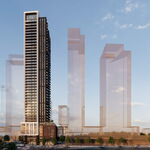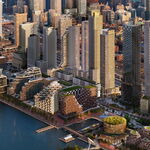I would guess it is a desire to keep it simple and express the overall design concept, letting the general impression sink in, without complicating matters with detail.That's a common and universal approach used by architects and designers, and it's good wisdom. It's amazing how much simple white blocks can convey.
My first impression was same, albeit the 'box' describes the clearance gauge which the catenary will clear
and the "catenary supports below bottom cord of truss" detail. It may not have been decided yet as to whether the "catenary" is to be suspended with give, or a rigid overheard bus, in which case the term 'catenary' becomes a misnomer. I'd guess the solid bus, it's far safer in an accident, especially with crowds adjacent, doesn't need to have 'give' as it's supported at many points, and the level of the roof can be a lot lower, which is why it's almost always used in tunnels and under bridges.
My fear, however, is it may be a sign that ML's architects have experience with public spaces, but have never seen or thought through the specifics of catenary.
Yeah....you could be labelled a cynic for stating that, but the proof is in that happening a number of times, Union Shed being a classic, albeit there's many tunnels (under the Hudson, for instance) where the overhead bus is much lower than Union Shed even. (Caveat added: Hudson Tunnels won't clear Amtrak or commuter bi-levels)
If ML wants to brag about its 'design excellence', they need to deliver the full package bafore anyone weighs in.
In all fairness to Metrolinx, there may be other drawings in the complete package that do show all mechanical/engineering details too, these might be simplified for the public, as you stated initially:
"I would guess it is a desire to keep it simple and express the overall design concept, letting the general impression sink in, without complicating matters with detail.That's a common and universal approach used by architects and designers, and it's good wisdom. It's amazing how much simple white blocks can convey."
I had an interesting discussion on the software renderings used of late, especially comparing them to ones more typical in European rail stations, with an architect prof friend just last week, how I have mixed feelings on the 'semi-transparent' figurines of people. I can understand why it is being done, but especially when it's in a video, as opposed to a static drawings, opaque figures look vastly more convincing to the eye in accepting the entire view. The challenge, of course, is not to obstruct the prime purpose of the illustration: the physical entity while still displaying usage.
"I see dead people"...comes to mind.
Btw: lol...they shrunk the adults in the renderings. Adult height is typically up to the level of the GO insignia on the front of MP40s. Those locos are big, but not that big.







